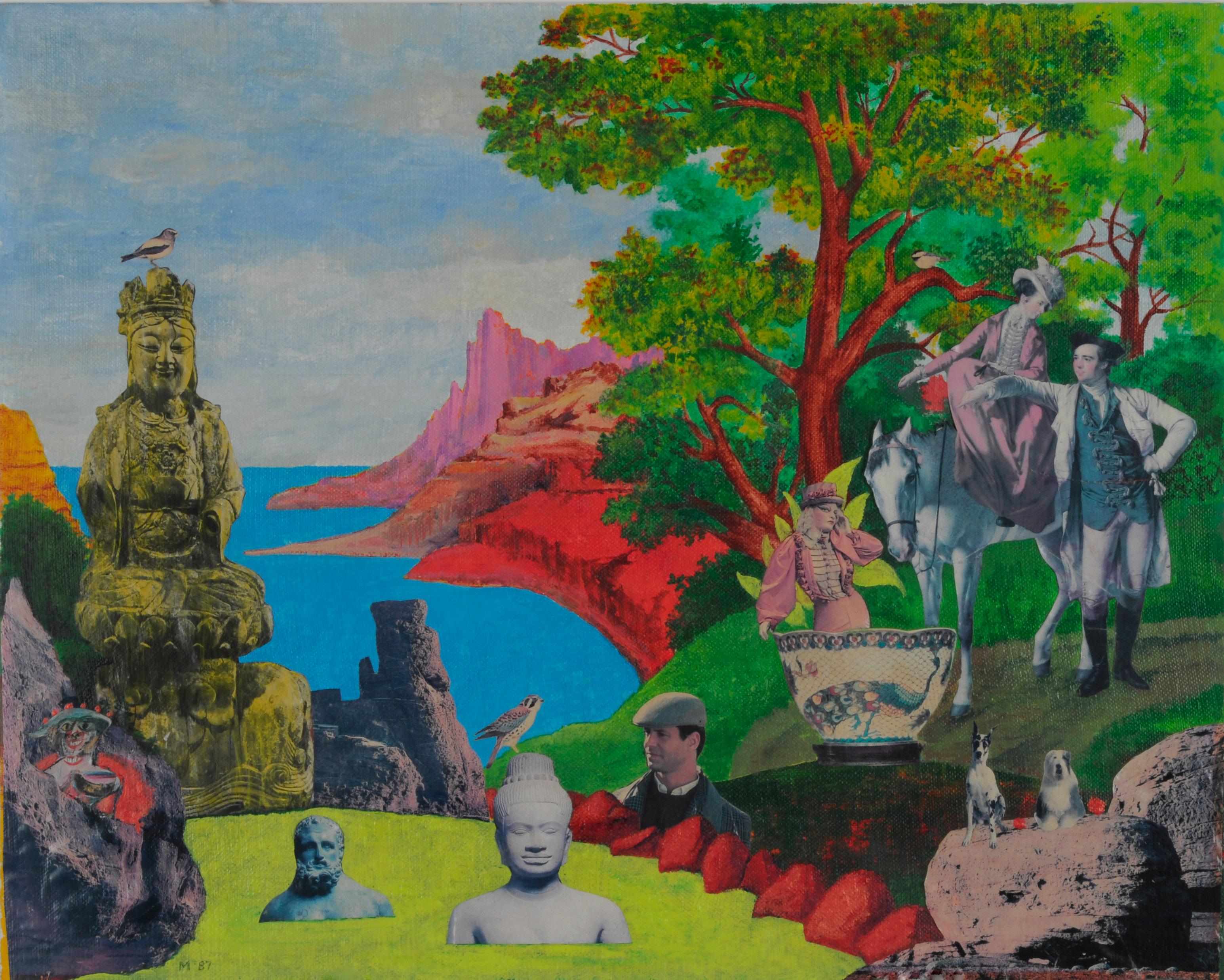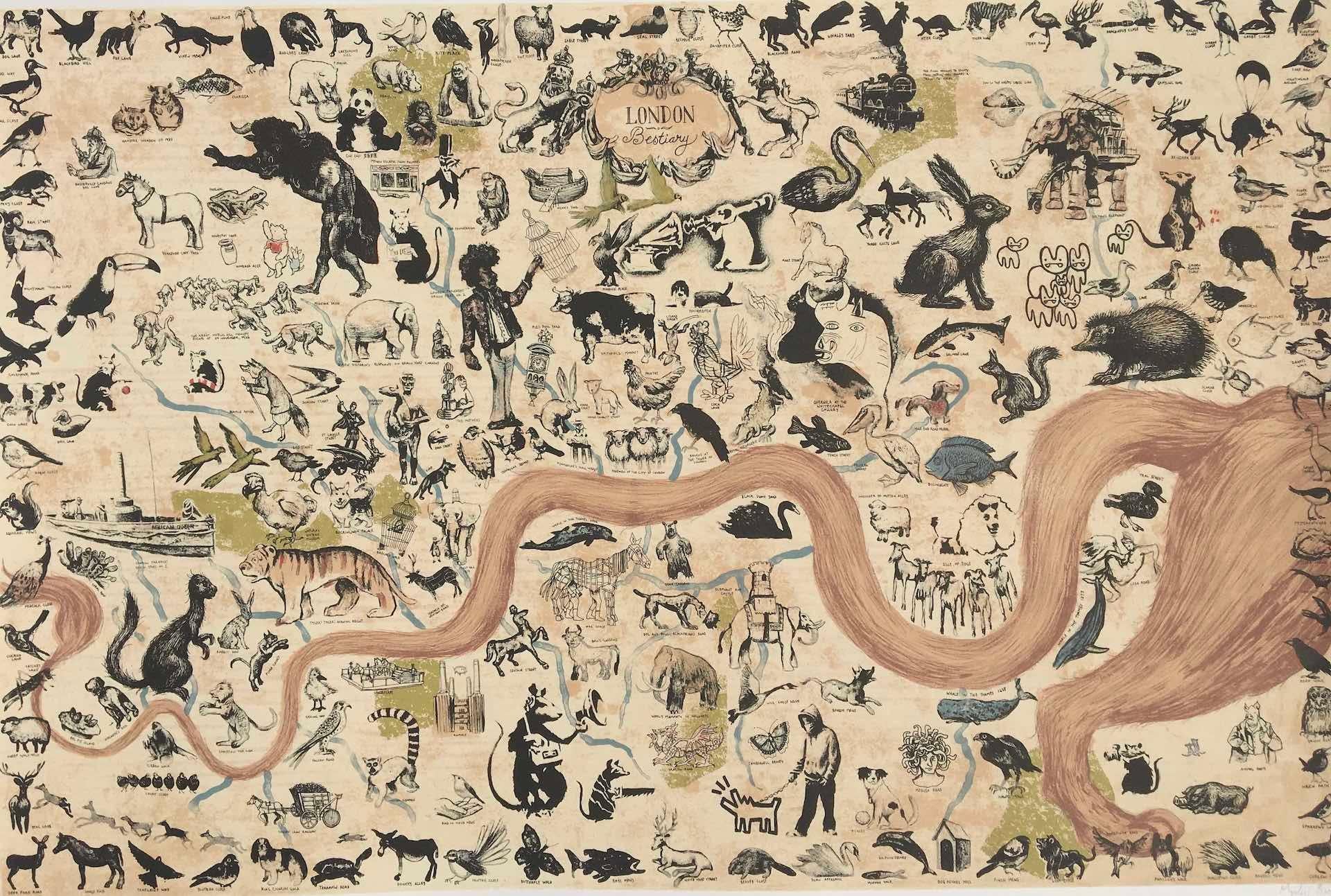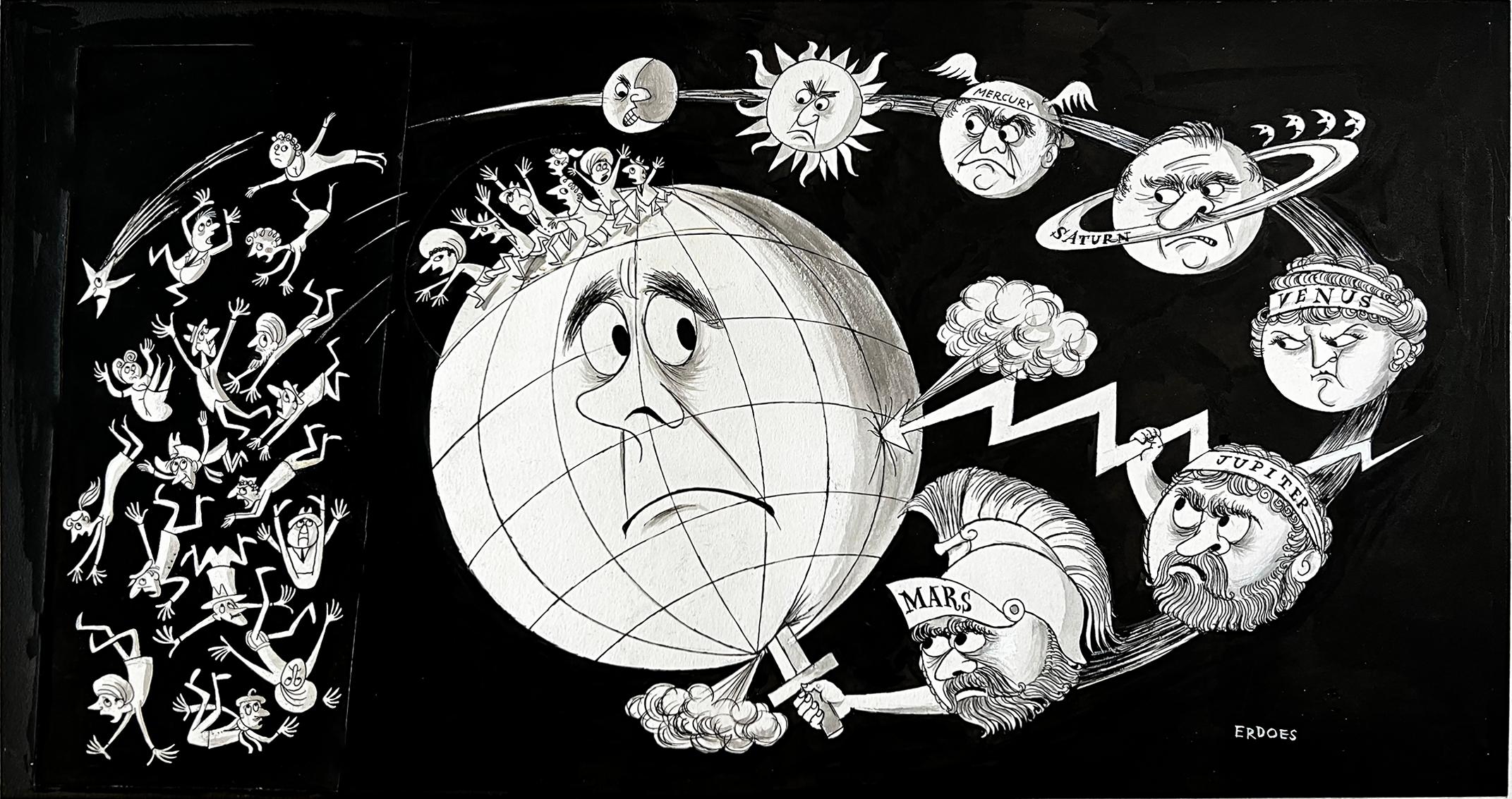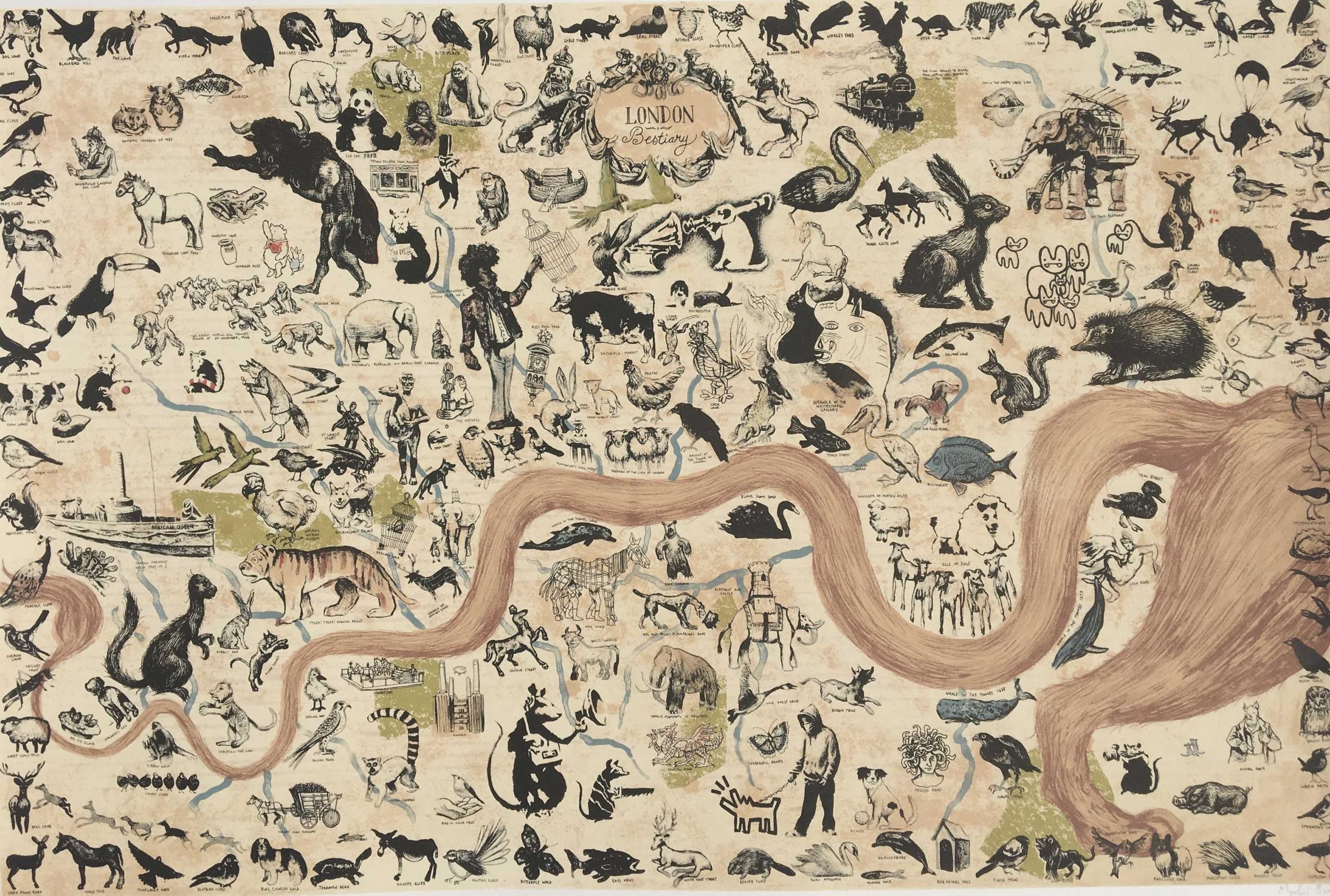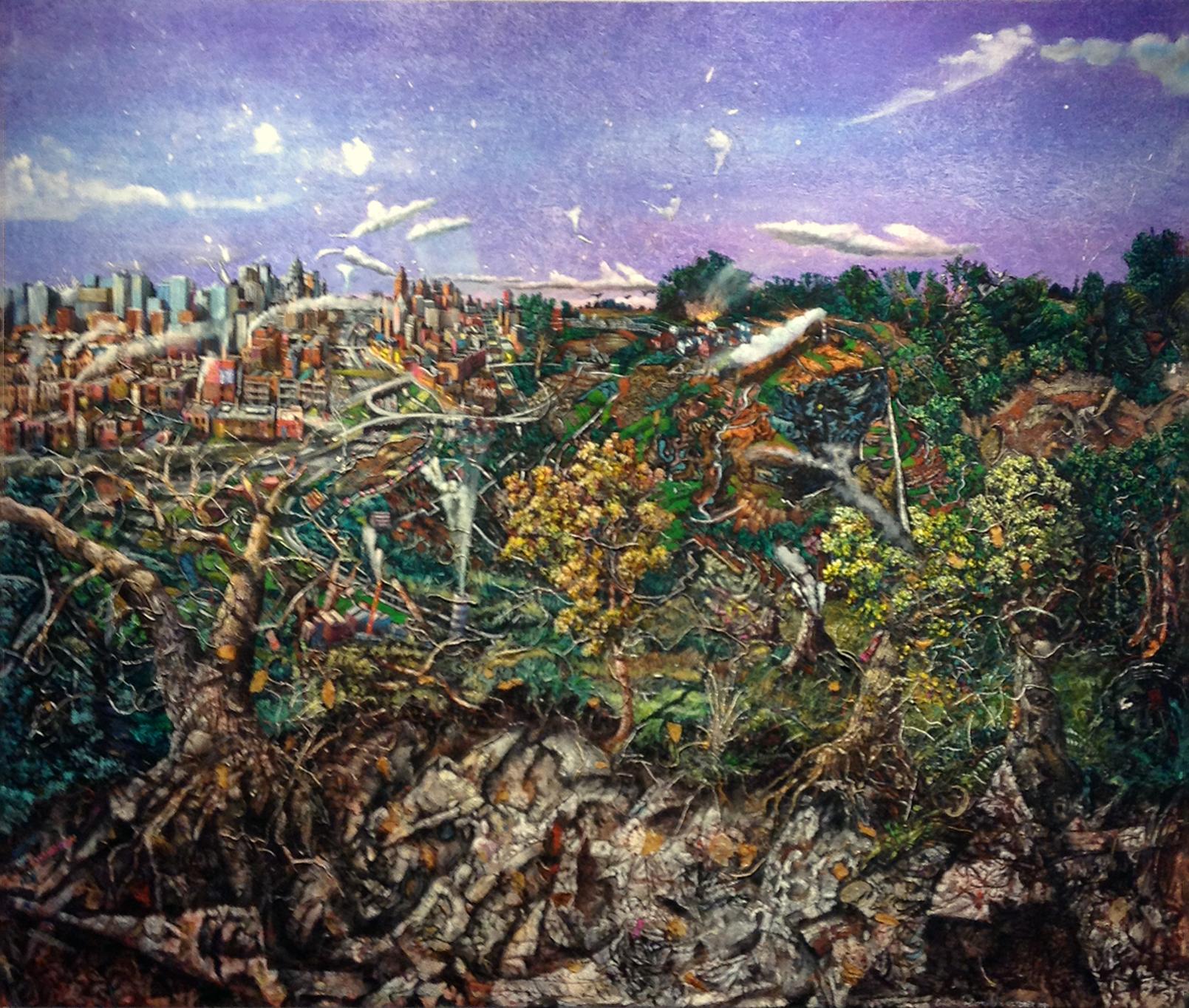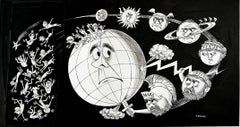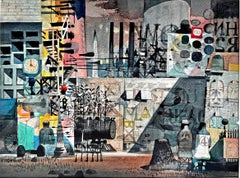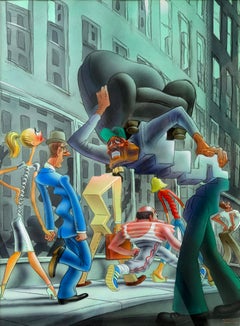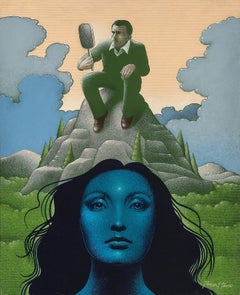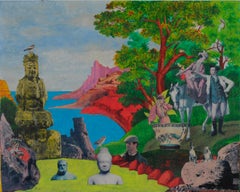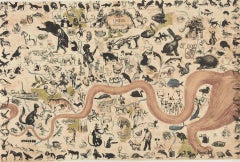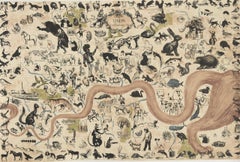Items Similar to Environmental Prognostication Coil Narrative "Homo Sapiens R.I.P."
Want more images or videos?
Request additional images or videos from the seller
1 of 19
Richard ErdoesEnvironmental Prognostication Coil Narrative "Homo Sapiens R.I.P."1969
1969
$12,500
£9,692.13
€10,992.29
CA$17,918.21
A$19,486.46
CHF 10,265.90
MX$236,666.78
NOK 129,063.15
SEK 120,986.28
DKK 82,526.93
About the Item
"They paved paradise and put up a parking lot," Joni Mitchell said. - - Created in 1969, at the dawn of the American environmental movement, artist Richard Erdoes draws a sequential narrative in the form of a coil. From inception to destruction, it illustrates a list of things that humans are doing to destroy the world we live in. The work was commissioned for school-age humans and executed in a whimsically comic way. Yet the underlying narrative is sophisticated and foreshadows a world that could be on the brink of ecological disaster.
Graphically and conceptually, this work exhibits an endless amount of creativity and Erdoes cartoony style is one to fall in love with.
Signed lower right. Unframed 12.4 inches Width: 12.85 inches Height is the live area. Board is 16x22 inches.
Richard Erdoes (Hungarian Erdős, German Erdös; July 7, 1912 – July 16, 2008) was an American artist, photographer, illustrator and author.
Early life
Erdoes was born in Frankfurt,to Maria Josefa Schrom on July 7, 1912. His father, Richárd Erdős Sr., was a Jewish Hungarian opera singer who had died a few weeks earlier in Budapest on June 9, 1912.After his birth, his mother lived with her sister, the Viennese actress Leopoldine ("Poldi") Sangora,He described himself as "equal parts Austrian, Hungarian and German, as well as equal parts Catholic, Protestant and Jew..."[4]
Career
He was a student at the Berlin Academy of Art in 1933, when Adolf Hitler came to power. He was involved in a small underground paper where he published anti-Hitler political cartoons which attracted the attention of the Nazi regime. He fled Germany with a price on his head. Back in Vienna, he continued his training at the Kunstgewerbeschule, now the University of Applied Arts, Vienna.[5] He also wrote and illustrated children's books and worked as a caricaturist for Tag and Stunde, anti-Nazi newspapers. After the Anschluss of Austria in 1938 he fled again, first to Paris, where he studied at the Academie de la Grande Chaumiere, and then London, England before journeying to the United States. He married his first wife, fellow artist Elsie Schulhof (d. xxxx) in London, shortly before their arrival in New York City.
In New York City, Erdoes enjoyed a long career as a commercial artist, and was known for his highly detailed, whimsical drawings. He created illustrations for such magazines as Stage, Fortune, Pageant, Gourmet, Harper's Bazaar, Sports Illustrated, The New York Times, Time, National Geographic and Life Magazine, where he met his second wife, Jean Sternbergh (d. 1995) who was an art director there. The couple married in 1951 and had three children.[6] Erdoes also illustrated many children's books.
An assignment for Life in 1967 took Erdoes to the Pine Ridge Indian Reservation for the first time, and marked the beginning of the work for which he would be best known. Erdoes was fascinated by Native American culture, outraged at the conditions on the reservation and deeply moved by the Civil Rights Movement that was raging at the time. He wrote histories, collections of Native American stories and myths, and wrote about such voices of the Native American Renaissance as Leonard and Mary Crow Dog and John Fire Lame Deer.[7] The Erdoes' New York City apartment was a well known hub of the American Indian Movement (AIM) in the early 1970sand he became involved in the legal defense of several AIM members.[citation needed] In 1975 the family moved to Santa Fe, New Mexico where Erdoes continued to write and remained active in the movement for Native American civil rights.
His papers are preserved at the Beinecke Rare Book and Manuscript Library at Yale University.[8]
Works
As author:
Peddlers and Vendors Around the World (1967)
Policemen Around the World (1967)
Musicians Around the World (1971)
The Sun Dance People: The Plains Indians, Their Past and Present (1972)
The Rain Dance People: The Pueblo Indians, Their Past and Present (1976)
The Woman Who Dared (1978)
Saloons of the Old West (1979)
The Native Americans: Navajos (1979)
Native Americans: The Sioux (1982)
Native Americans: The Pueblos (1983)
The Richard Erdoes Illustrated Treasury of Classic Unlaundered Limericks (1984) I
A.D. 1000: Living on the Brink of Apocalypse (1988)
Crying for a Dream: The World through Native American Eyes (1990)
Tales from the American Frontier (1992) ISSN 0362-8930
Legends and Tales of the American West (1998) I
As illustrator:
The Cat and The Devil (1964) by James Joyce
Come over to My House (1966) by Theo. LeSieg (pen name of Theo Geisel aka Dr. Seuss)[
The Spotted Stones (1978) by Silvio Bedini
- Creator:Richard Erdoes (1912 - 2008, American)
- Creation Year:1969
- Dimensions:Height: 12.4 in (31.5 cm)Width: 12.85 in (32.64 cm)Depth: 1 in (2.54 cm)
- Medium:
- Movement & Style:
- Period:
- Condition:
- Gallery Location:Miami, FL
- Reference Number:1stDibs: LU385313934052

About the Seller
5.0
Vetted Professional Seller
Every seller passes strict standards for authenticity and reliability
Established in 2005
1stDibs seller since 2016
117 sales on 1stDibs
Typical response time: 1 hour
- ShippingRetrieving quote...Shipping from: Miami, FL
- Return Policy
Authenticity Guarantee
In the unlikely event there’s an issue with an item’s authenticity, contact us within 1 year for a full refund. DetailsMoney-Back Guarantee
If your item is not as described, is damaged in transit, or does not arrive, contact us within 7 days for a full refund. Details24-Hour Cancellation
You have a 24-hour grace period in which to reconsider your purchase, with no questions asked.Vetted Professional Sellers
Our world-class sellers must adhere to strict standards for service and quality, maintaining the integrity of our listings.Price-Match Guarantee
If you find that a seller listed the same item for a lower price elsewhere, we’ll match it.Trusted Global Delivery
Our best-in-class carrier network provides specialized shipping options worldwide, including custom delivery.More From This Seller
View AllApocalypse, Catastrophic Destruction of the World, Surrealism - Life Magazine
Located in Miami, FL
Apocalypse in 1962? At the height of the Cold War, Life Magazine commissions an illustration that describes the world's end by means other than a nuclear war with Russia. Richard Erdoes brilliantly illustrates the work with his highly stylized painting technique. My favorite part of the work is on the left side showing a group of people packed together as they fall into oblivion. A clear reference would be Hieronymus Bosch's "The Last Judgment "
Once Again the World Ends." Illustration published in Life Magazine, Feb. 9, 1962
Signed in lower right image.
Unframed
Richard Erdoes (Hungarian Erdős, German Erdös; July 7, 1912 – July 16, 2008) was an American artist, photographer, illustrator and author.
Early life
Erdoes was born in Frankfurt,[1] to Maria Josefa Schrom on July 7, 1912. His father, Richárd Erdős Sr., was a Jewish Hungarian opera singer who had died a few weeks earlier in Budapest on June 9, 1912.[2] After his birth, his mother lived with her sister, the Viennese actress Leopoldine ("Poldi") Sangora,[3] He described himself as "equal parts Austrian, Hungarian and German, as well as equal parts Catholic, Protestant and Jew..."[4]
Career
He was a student at the Berlin Academy of Art in 1933, when Adolf Hitler came to power. He was involved in a small underground paper where he published anti-Hitler political cartoons which attracted the attention of the Nazi regime. He fled Germany with a price on his head. Back in Vienna, he continued his training at the Kunstgewerbeschule, now the University of Applied Arts, Vienna.[5] He also wrote and illustrated children's books and worked as a caricaturist for Tag and Stunde, anti-Nazi newspapers. After the Anschluss of Austria in 1938 he fled again, first to Paris, where he studied at the Academie de la Grande Chaumiere, and then London, England before journeying to the United States. He married his first wife, fellow artist Elsie Schulhof (d. xxxx) in London, shortly before their arrival in New York City.
In New York City, Erdoes enjoyed a long career as a commercial artist, and was known for his highly detailed, whimsical drawings. He created illustrations for such magazines as Stage, Fortune, Pageant, Gourmet, Harper's Bazaar, Sports Illustrated, The New York Times, Time, National Geographic and Life Magazine, where he met his second wife, Jean Sternbergh (d. 1995) who was an art director there. The couple married in 1951 and had three children.[6] Erdoes also illustrated many children's books.
An assignment for Life in 1967 took Erdoes to the Pine Ridge Indian Reservation for the first time, and marked the beginning of the work for which he would be best known. Erdoes was fascinated by Native American culture, outraged at the conditions on the reservation and deeply moved by the Civil Rights Movement that was raging at the time. He wrote histories, collections of Native American stories...
Category
1960s Surrealist Figurative Drawings and Watercolors
Materials
Mixed Media, Gouache, Board, Illustration Board
Early Street Art - New York Urban Factory Scene - Mid Century - Factory X
By Dong Kingman
Located in Miami, FL
This early work from 1955 by Dong Kingman N.A. is as surreal as it is a document of a place. The artist effectively captures a slice of American urban life but constructs the compo...
Category
1950s Surrealist Landscape Drawings and Watercolors
Materials
Watercolor, Rag Paper
$20,000 Sale Price
20% Off
Twisted People. Time Magazine Cover Proposal - Like Antony Gormley
Located in Miami, FL
Boundless whimsical creativity defines this Time Magazine Cover proposal. In 1970, famed illustrator/artist Robert Grossman visualized a cover story i...
Category
1970s Figurative Paintings
Materials
Gouache, Illustration Board
Sexual Issues, Cosmopolitan Magazine Illustration
Located in Miami, FL
Brilliant 1970s illustrator Roger Hane paints a surreal scene depicting a beautiful girl with flowing black hair, a strong jawline, and a blue cast to her f...
Category
1970s Figurative Paintings
Materials
Canvas, Acrylic
Animal Kingdom, Zebra, Buffalo, Lion, Giraffe, Elephant, Monkey, Tiger, Gorilla
By Richard Hess
Located in Miami, FL
Peaceable Kingdom features more than 60 aminal portraits by famous illustrator Richard C. Hess.
Impeccably rendered and designed. Signed lower center-left. R. Hess.
His illustrati...
Category
1980s Surrealist Animal Paintings
Materials
Acrylic
$20,000 Sale Price
20% Off
Animal Kingdom, Zebra, Buffalo, Lion, Giraffe, Elephant, Monkey, Tiger, Gorilla
By Richard Hess
Located in Miami, FL
Peaceable Kingdom features more than 60 aminal portraits by famous illustrator Richard C. Hess.
Impeccably rendered and designed. Signed lower center left. R. Hess.
His illustrati...
Category
1980s Surrealist Animal Paintings
Materials
Acrylic
$20,000 Sale Price
20% Off
You May Also Like
Impossible Solutions at The Fountain of Youth
Located in Fairlawn, OH
Impossible Solutions at The Fountain of Youth
Collage on paper, 1987
Signed with the artist's initials and datedlower left
Condition: Good, with the ...
Category
1980s Surrealist Figurative Drawings and Watercolors
Materials
Paper
Mychael Barratt, London Bestiary, Animal Art, Illustrated Cityscape, Happy Art
By Mychael Barratt
Located in Deddington, GB
London Bestiary by Mychael Barratt
Limited Edition Etching: Edition of 100
Image Size: H 66m x W 99.7cm
Complete size of Sheet: H 76.9cm x W 112.1cm x D 0.1cm
Signed and titled
Sold ...
Category
2010s Contemporary Landscape Prints
Materials
Paper, Screen
London Bestiary, Art print, Animals Art, Contemporary Art, Figurative
By Mychael Barratt
Located in Deddington, GB
London Bestiary by Mychael Barratt. Limited Edition Silkscreen Print. Edition of 100. Image Size: H 66cm x W 99.7cm. Sheet Size: H 112.1cm x W 76.9cm x D 0.1cm. Signed and titled. So...
Category
2010s Contemporary Figurative Prints
Materials
Screen
Untitled
Located in Barcelona, BARCELONA
the painting is being offered with a work and authenticity certificate
Category
2010s Drawings and Watercolor Paintings
Materials
Paper, Mixed Media
It's All So Distrurbing
By Robert Gadomski
Located in Three Oaks, MI
Robert Gadomski's paintings, which utilize various techniques, are of natural and urban settings, most inspired by South Side neighborhoods such as Marquette Park, where he grew up, ...
Category
1980s Surrealist Landscape Paintings
Materials
Oil
$6,400 Sale Price
20% Off
Gross Domestic Product
Located in Toronto, ON
16.5" x 21.5" Unframed
Original Watercolour
Hand Signed by Joe Lasker
Category
21st Century and Contemporary Figurative Drawings and Watercolors
Materials
Watercolor
